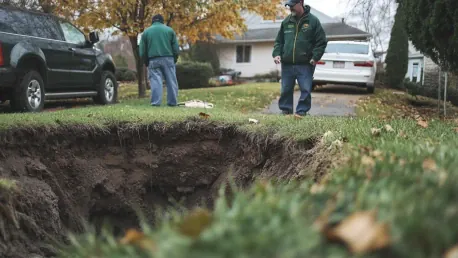Sinkholes pose a significant yet often overlooked risk to homeowners, with both financial and human consequences. These depressions, caused by the sudden collapse of land, can lead to costly damages and even fatalities. Despite their severe impact, sinkholes often fail to receive the attention they deserve. Homeowners, typically more concerned with common natural disasters like hurricanes or floods, often neglect the peril that sinkholes present. However, the suddenness and potential severity of sinkhole incidents make them a formidable threat that warrants closer scrutiny and proactive measures.
The Financial Toll of Sinkholes
The financial burden of sinkholes on homeowners is substantial. In Florida alone, the average sinkhole claim in 2020 exceeded $140,000. This figure highlights the steep costs that can arise from sinkhole damage, making it crucial for homeowners to be prepared. Without adequate insurance coverage, these costs can be financially ruinous. Homes can be rendered uninhabitable, and repairs are often extensive and expensive, involving not just the filling of the hole but substantial structural work to stabilize the property.
Homeowners’ insurance policies generally do not cover sinkholes. To obtain coverage, homeowners must purchase a specific add-on, which can cost between $2,000 and $4,000 annually in Florida. Without this coverage, the financial responsibility for sinkhole damage falls directly on the homeowner. This add-on can provide peace of mind but also constitutes a significant additional expense. The dilemma for many homeowners is weighing the annual cost of insurance against the potentially devastating financial impact of a sinkhole event. The gap in standard coverage underscores the need for homeowners, especially in high-risk areas, to take additional steps to protect their properties.
Geographic Prevalence of Sinkholes
Sinkholes are particularly prevalent in certain states, with Florida experiencing the highest frequency. Regions like Tampa Bay and “sinkhole alley” (Hernando, Pasco, and Hillsborough counties) are especially susceptible. However, other states such as Alabama, Kentucky, Missouri, Pennsylvania, Tennessee, and Texas also face significant sinkhole risks. The geological composition of these areas, often rich in limestone, makes them more prone to the formation of sinkholes as water erodes the subterranean rock. This demographic insight emphasizes the importance of geographical awareness when evaluating property risks.
This geographic distribution underscores the need for broader awareness and proactive measures across various regions. Homeowners in these areas must remain vigilant and consider the potential necessity of preventive actions. By understanding their local geology and the historical prevalence of sinkholes in their areas, residents can better gauge their risk and take appropriate measures. Furthermore, community-level initiatives and government support can also play crucial roles in mitigating this risk, illustrating that individual preparation must be complemented by broader societal efforts to address the issue comprehensively.
Formation and Detection of Sinkholes
Understanding how sinkholes form is crucial for homeowners in vulnerable areas. Sinkholes typically emerge in regions with abundant underground water that erodes rock foundations, particularly limestone. The water dissolves small amounts of rock, creating voids that eventually cause the surface land to collapse. This process is often insidious and can continue unnoticed until a critical point is reached, leading to sudden and dramatic land collapses. The science behind sinkholes highlights the importance of geological assessments and consistent monitoring for signs of underground erosion.
The U.S. Geological Survey (USGS) notes that efficient systems to predict sinkholes are limited. This lack of predictive capability raises the stakes for homeowners regarding preparedness and preventive assessments. While some early warning signs, such as surface cracks and slumping ground, might be detectable, many sinkholes develop with little to no advance warning. As a result, homeowners need to rely on regular inspections and professional assessments to identify vulnerabilities and address them promptly. This proactive approach, while time-consuming and sometimes costly, is essential in mitigating the risks posed by these unpredictable geological events.
Preventive Measures for Homeowners
Thorough inspections before purchasing property in sinkhole-prone areas are essential. Engaging experienced real estate agents, local home inspectors, foundation specialists, or licensed geologists can provide valuable insights into the land’s stability. These professionals can detect subtle signs of potential risks and offer recommendations for further investigations. Pre-purchase inspections can save potential homeowners from inheriting significant future problems and ensure they are making informed decisions about their investment.
Additionally, Florida’s Department of Environmental Protection offers a map of reported subterranean events. This resource can help home buyers and current property owners assess potential sinkhole risks and make informed decisions. Access to such detailed, localized data empowers homeowners to evaluate their individual risk profiles and take appropriate actions, whether through structural reinforcements, insurance coverage, or even reconsidering property transactions. Such proactive measures underscore an essential principle for dealing with sinkholes: knowledge and preparedness are critical in managing the unpredictable nature of these geological phenomena.
The Human Impact of Sinkholes
The human toll of sinkholes can be devastating. The 2013 death of Jeffrey Bush in Seffner, Florida, serves as a tragic reminder of the deadly nature of these occurrences. Such incidents highlight the importance of awareness and preparedness for homeowners. The psychological impact of living with the potential threat of a sinkhole can also be significant, causing stress and anxiety for those in high-risk areas. Beyond physical destruction, sinkholes can disrupt lives, displace families, and create long-lasting emotional scars.
While sinkhole events may appear limited compared to other natural disasters, their catastrophic damage warrants serious consideration. Homeowners must weigh the low probability of occurrence against the potential for profound consequences. This consideration is particularly pressing in regions where sinkholes are more common, but it also bears relevance in areas with emerging risks. Just as with other natural disasters, the unpredictability of sinkholes necessitates a balanced approach that considers both preventive measures and emergency planning. Such planning ensures that individuals and communities are better equipped to respond to and recover from these sudden, destructive events.
Vigilance and Early Detection
Sinkholes represent a significant but often underestimated risk to homeowners, resulting in both financial and human consequences. These depressions in the ground happen when the land suddenly collapses, leading to potentially expensive property damage and even fatalities. Despite the severity of their impact, sinkholes frequently don’t get the attention they deserve. Homeowners are typically more worried about common natural disasters like hurricanes or floods, and therefore, they often ignore the threat posed by sinkholes. However, the sudden and severe nature of sinkhole occurrences makes them a serious hazard that deserves increased awareness and preventive actions. Being proactive in identifying risk areas and taking necessary measures can help mitigate the damage caused by sinkholes. Educating the public on this matter can lead to a better understanding of the risks involved and encourage more homeowners to invest in protection. Therefore, giving sinkholes the scrutiny they warrant is essential for the safety and security of homeowners and their properties.









